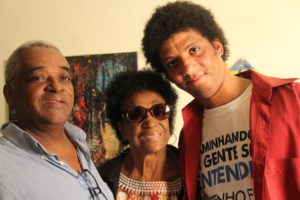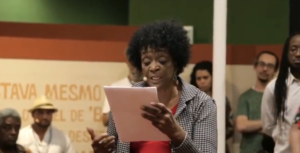Photos: Paulo Mileno\YouTube Screenshots\Wikimedia Commons
[Below Photo: Abdias Nascimento Filho, Léa Garcia and Paulo Mileno.]
Actress Léa Garcia‘s legacy in Brazilian history is inextricably intertwined with her career and her lifelong commitment to Black consciousness. These two aspects of her life cannot be separated.

Her journey began in 1952 when she embarked on a mission to challenge stereotypical roles for Black actors and combat the use of blackface by white actors.
Her association with the powerful Teatro Experimental do Negro (Black Experimental Theater), led by Abdias Nascimento—a Brazilian poet, writer, artist, political activist, and former national deputy and senator—became the cornerstone of her efforts. Nascimento was the biggest voice of the Brazilian Black community around the world.
Léa Garcia was not just an actress. She was also the wife of Abdias Nascimento, and together, they had two sons, Henrique Christovão Garcia and Abdias Nascimento Filho. Later in life, she married the producer and writer Armando Aguiar and had her last son, Marcelo Garcia.
Living to the remarkable age of ninety, Léa Garcia left behind a lasting legacy that continues through her descendants, including three grandchildren, two great-grandchildren, and a great-great-granddaughter.
In interviews, Ms. Garcia consistently emphasized the pivotal role of Teatro Experimental do Negro (TEN) in social development and education for housekeepers and Black individuals. Regrettably, despite its significance, TEN remains relatively unknown in today’s society, even though it predates the well-recognized Paulo Freire method introduced in 1963.
During her tenure at TEN, Léa played key roles in groundbreaking productions such as Rapsódia Negra (Black Rhapsody), O Imperador Jones (The Emperor Jones), Sortilégio – Mistério Negro (Enchantment) – Black Mystery), and the classic Orfeu da Conceição (Orpheus of Conceição). The latter marked the initial musical partnership between composer Antônio Carlos Jobim and the poet and former diplomat Vinicius de Moraes in 1956.
Notable figures like the renowned architect Oscar Niemeyer also contributed to this theater, with Niemeyer later playing a crucial role in the construction of the planned city of Brasília, the capital of Brazil.
In 1959, French filmmaker Marcel Camus adapted one of these masterpieces into a movie known as Black Orfeu. The film, produced through a collaboration between France, Italy, and Brazil, gained popularity in the United States, securing the Academy Award for Best Foreign Language Film and the Golden Palm at the Cannes Film Festival.
At the Golden Palm awards, Ms. Garcia received recognition as the second-best actress globally for her role in Black Orpheus. Throughout her illustrious career, Léa Garcia received numerous accolades. She earned the Silver Armadillo for Best Actress for the short film “Memórias da Chibata” (Memories of the Whip) in 2007 and an honorable mention at the 2008 Gramado Film Festival for her performance in “Hoje tem Ragu” (Today has Regu).

In 2004, she was bestowed with the Kikito Award for Best Actress at the Gramado Film Festival for “Filhas do Vento” (Daughters of the Wind), and her performance resonated with the festival’s audience jury, winning her the Best Actress award. Tragically, just before receiving a lifetime achievement award at the same Gramado Film Festival in August 2023, she suffered a heart attack.
As a prominent figure, she received the Pedro Ernesto Medal from the Rio de Janeiro City Council in 1994, the medal from the Brazilian Academy of Letters, and the Golden Dolphin from the Rio de Janeiro State Cultural Council.
In Brazil, Ms. Garcia gained widespread recognition for her portrayal of Rosa in the 1976 soap opera, Escrava Isaura (Isaura: Slave Girl), which reached millions of viewers worldwide, including China.
Despite her numerous accomplishments, Léa Garcia expressed regret that the Black community did not fully acknowledge her journey. Notably, she transformed the portrayal of Black characters, particularly when she was involved in rewriting scripts together with activists Amauri Mendes and Iêdo Ferreira for her character as a history teacher in the 1980 TV Globo soap opera Marina.
This marked the first time a soap opera script was altered to allow an actress to collaborate with the director and screenplay writers, resulting in a powerful portrayal of Black consciousness and narrative. Unfortunately, this transformation wasn’t always appreciated by Black community activists.
Ms.Garcia also served as a council member of the Rio de Janeiro State’s Culture Council between 1999 and 2001. In 2010, she was elected as the artistic director of Union Artists and Technicians Shows and Directing. In her association to the Cinema Industry Technicians Union as a cinema storyteller, Léa wrote the scripts for two films.
Her feature film, Aconteceu no Rio de Janeiro (Happened in Rio de Janeiro), was an adaptation of four tales by Brazilian authors, including “O Batizado” by Cuti, “O Cobrador e o Deus Vaca,” (O Cobrador e o Deus Vaca) and “Aconteceu no Rio de Janeiro” (Happened in Rio de Janeiro) by Cidinha da Silva and “Vovó Veio para Jantar” (Grandma Came to Dinner) by Muniz Sodré. Her fictional medium-length film, Dublê de Ogum (Ogum’s Double), was based on Cidinha da Silva’s homonymous tale.
As a producer, she created a short documentary about Ruth de Souza titled Um Ser Humano Que A Gente Quer Guardar (A Human Being We Want to Care). Additionally, she worked on Deus Abençoe Você (God Bless You), a radio theater production, and Carolina, O Luxo do Lixo (Carolina, the Luxury of Garbage), a theatrical performance.
She and I co-authored the theater show Abdias Nascimento, O Leão Africano! (Abdias Nascimento, The African Lion!).

For the first time, I took on the role of fundraising and project realization. As a filmmaker, she was involved in my impactful projects such as Quilombismo Em Tempos de Guerra! (Quilombism in Times of War!) and Encruzilhada entre Terreiro e Quilombo em Jacarepaguá: Ressignificação Civilizatória no Sertão Carioca (Terreiro and Quilombo Crossroads in Jacarepaguá: The Resignification of Civilization in the Sertão Carioca).
Upon reflection, it is evident that Léa Garcia’s presence has been a constant thread running through all these my projects. Her contributions, whether in written words or vocal expressions, have illuminated untold stories, overlooked narratives, and messages that need to be shared and propagated.
Nonetheless, as Ms. Garcia said, to Black community, more important than the character, Black community needs to be the director, who writes and conceives the overall idea.
However, what truly matters for a Black character is whether that character holds significance in the narrative, because, sometimes a Black character, be it a lawyer or a doctor, it only serves as a passage to another whiter character in the story.
At Garcia’s funeral, as articulated by the babalawo Ivanir dos Santos, death is not the final chapter, but rather a poignant juncture where one reunites with their ancestors in Yoruba, Fon, Bantu, and various other African nations.
During Ms. Garcia’ funeral, Marcelo Garcia conveyed that Léa possessed a profound spiritual connection. She found herself immersed in a dream one day with her ‘beloved ones’. They touched carefully in her head and certainly helped on her path to the Orun. May she rest in power, in peace, in paradise with the ancestors.
Léa Garcia’s legacy will continue to shine like a lighthouse whose light never fades. She has now become a star in the sky.

“It takes a revolution (revolution) to make a solution”–Bob Marley
Paulo Mileno is an actor, filmmaker cultural producer, writer, editorial advisor of Africa and Africanities Magazine and he was researcher in the Nucleus of African Philosophy at the State University of Rio de Janeiro (Brazil). Mileno also writes to Observatório da Imprensa (São Paulo – Brazil), Brasil de Fato (São Paulo – Brazil), Jornal do Brasil (Rio de Janeiro – Brazil), Black History Month (London – England), Ufahamu: A Journal of Black Studies from Los Angeles University -UCLA (Los Angeles – USA), San Francisco National Black Newspaper (San Francisco – USA), Black Star News (New York – USA) and Africa Business (Cape Town – South Africa). Reach him via [email protected]






